Animals Chapter Notes | Science Olympiad for Class 2 PDF Download
| Table of contents |

|
| Classification of Animals |

|
| Domestic Animals |

|
| Wild Animals |

|
| Water Animals |

|
| Land Animals |

|
| Eating Habits of Animals |

|
Classification of Animals
Animals are living things that can be found on land, in the air, and in water. We encounter them in various places like our homes, on the road, in gardens, zoos, and circuses. Animals eat different types of food and are helpful to us in many ways. An animal's home is called its habitat. Animals can be classified into various types.
Here's a table list of different homes of animals:
| Animal | Home/Habitat |
|---|---|
| Lion | Grasslands and Savannas |
| Polar Bear | Arctic Tundra |
| Squirrel | Trees and Tree Hollows |
| Beaver | Lodges or Dams in Rivers |
| Ant | Ant Nest or Anthill |
| Penguin | Icebergs and Rocky Shores |
| Rabbit | Burrows or Rabbit Holes |
| Spider | Webs or Underground Burrows |
| Dolphin | Oceans and Seas |
| Turtle | Shallow Waters and Beaches |
| Owl | Trees or Nest Boxes |
| Fish | Rivers, Lakes, and Oceans |
| Kangaroo | Grasslands and Forests |
| Snail | Shells or Under Rocks |
| Elephant | Grasslands and Forests |
| Honeybee | Beehives or Hollow Trees |
| Frog | Ponds and Marshes |
| Bat | Caves and Trees |
| Elephant Seal | Coastal Beaches |
| Hermit Crab | Empty Shells and Underwater Caves |
Domestic Animals
Domestic animals are animals that live near us, either on farms or in our homes. They can be farm animals or pets.
Examples of Domestic animals are Dogs, Cows, Horses, Sheeps, Pigs etc.
Pet Animals
(a) Pet animals are a special kind of domestic animals that live with humans in their homes.
(b) They are kept as companions and are loved by their owners.
(c) Pet owners provide them with food, care, and a place to live.
(d) Common pet animals include dogs, cats, fish, birds, rabbits, and hamsters.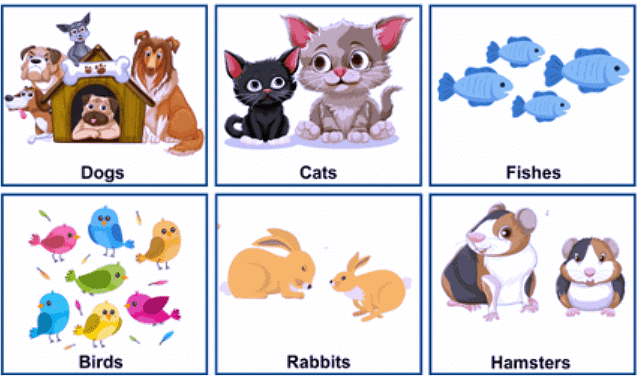
Farm Animals
(a) Farm animals are animals that are kept on farms.
(b) They provide us with many useful things and some even help us with work.
(c) Examples of farm animals are cows, buffaloes, goats, sheep, donkeys, hens, and ducks.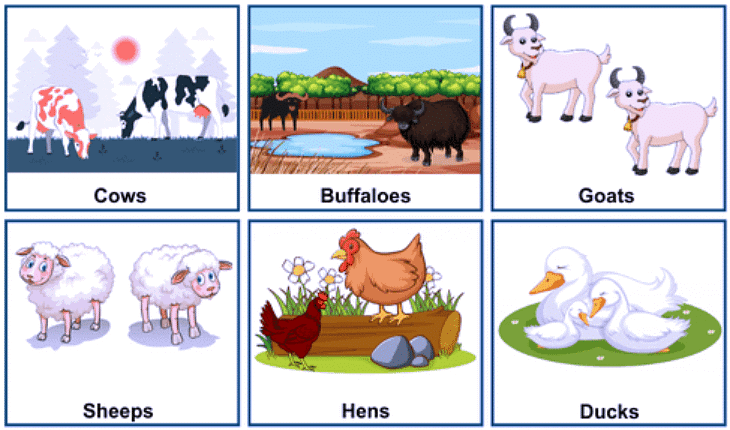
(d) On the farm, we build homes for these animals. We have special places called coops for hens, sheds for cows, stables for horses, and sties for pigs. These homes keep the animals safe and comfortable.
Things we get from Farm Animals
(a) Some animals like cows, goats, and buffaloes give us milk. We use milk to make curd, butter, and cheese.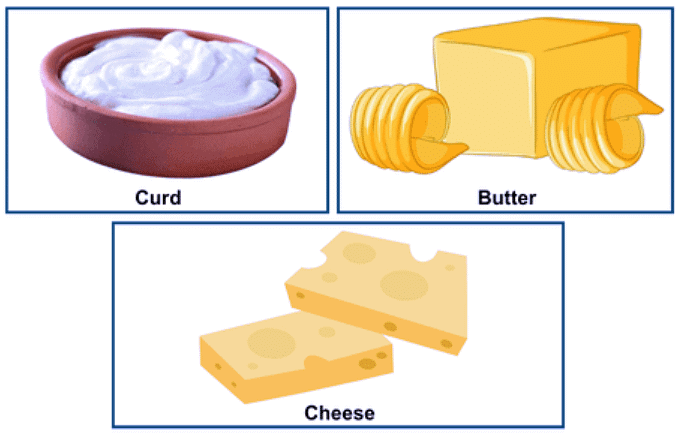
(b) Birds like hens, geese, and ducks give us eggs to eat.
(c) We also eat fish and the meat of other animals like goats and hens.
(d) From beehives, we get honey and beeswax. Beeswax is used to make candles.
(e) Silkworms are insects that give us silk. Silk is a material used to make beautiful clothes.
(f) Wool is obtained from the hair or fur of animals like sheep, goats, camels, and rabbits. We use wool to make sweaters, mufflers, socks, gloves, and shawls.
(g) We get leather from the skin of animals like camels, snakes, and buffaloes. Leather is used to make many different products, like bags, shoes, and belts.
Wild Animals
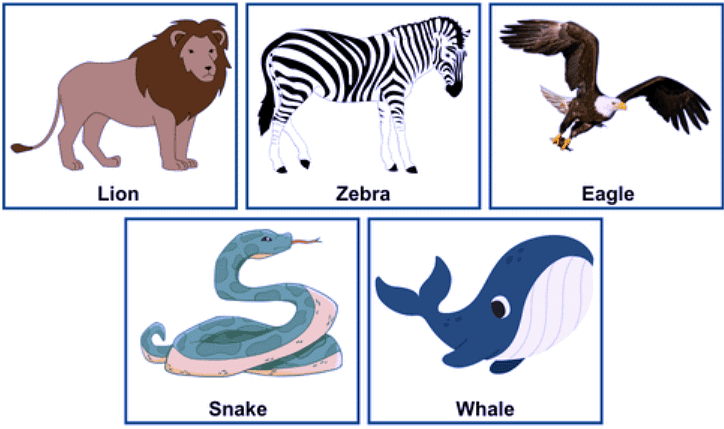
(a) Wild animals are creatures that live in nature without humans taking care of them.
(b) They are free to roam in places like deserts, forests, mountains, grasslands, and oceans.
(c) Examples of wild animals are lions, zebras, eagles, snakes, whales, and many more.
(d) Wild animals find their homes in natural places like dens, caves, and lakes.
Water Animals
(a) Water animals are creatures that live mainly in water, like rivers, lakes, and oceans.
(b) They are also called aquatic animals.
(c) Examples of water animals are fish, sharks, whales, octopuses, and turtles.
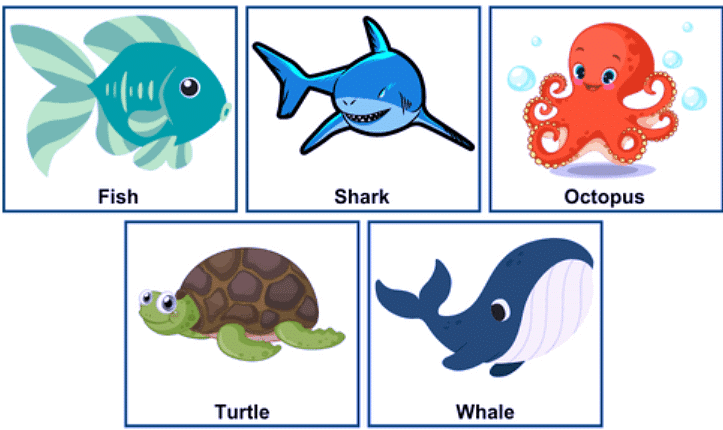
Land Animals
(a) Land animals are those that live mainly on land, such as in forests, mountains, deserts, and grasslands.
(b) They are also known as terrestrial animals.
(c) Lions, elephants, bears, wolves, giraffes, deer, and kangaroos are some land animals.
Examples of Terrestial animal
| Animal | Description |
|---|---|
| Lion | A large, carnivorous cat that lives in grasslands and savannas. |
| Elephant | The largest land animal known for its trunk and big ears. |
| Giraffe | Tall herbivores with long necks that live in grassy areas. |
| Tiger | A large, striped cat found in forests and grasslands. |
| Kangaroo | Marsupials from Australia known for hopping on their strong hind legs. |
| Bear | Large, omnivorous mammals that hibernate during winter. |
| Zebra | Black and white striped herbivores found on African grasslands. |
| Hippopotamus | Large, amphibious animals that spend a lot of time in water. |
| Rhinoceros | Large herbivores with one or two horns on their snouts. |
| Wolf | Carnivorous canines that live in packs and hunt together. |
| Cheetah | Fastest land animals, known for their speed and spotted coats. |
| Gorilla | Large, strong primates that live in forests and are closely related to humans. |
| Fox | Small to medium-sized carnivores with bushy tails. |
| Panda | Black and white bears native to China that eat bamboo. |
| Koala | Marsupials from Australia known for eating eucalyptus leaves. |
| Hedgehog | Small, spiky mammals that curl into a ball for protection. |
| Ostrich | Flightless birds with long legs and necks, native to Africa. |
| Camel | Desert-dwelling animals known for their humps and ability to store water. |
| Sloth | Slow-moving mammals that live in trees and eat leaves. |
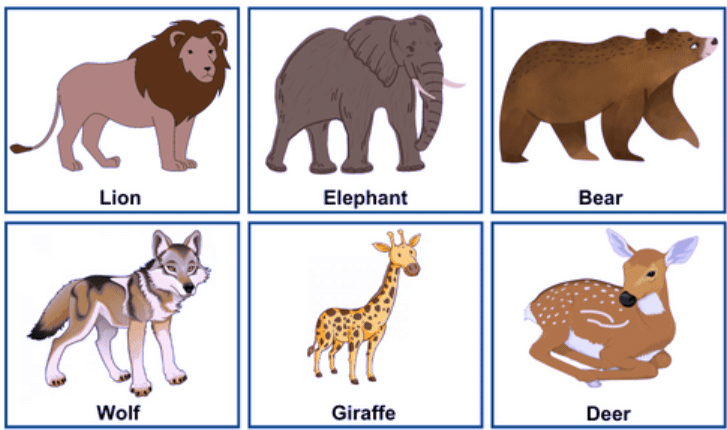
Eating Habits of Animals
Animals can be put into different groups based on what they eat. Such as:
 |
Download the notes
Chapter Notes: Animals
|
Download as PDF |
Herbivores
(a) Herbivores are animals that mostly eat plants.
(b) They enjoy munching on leaves, stems, and fruits.
(c) They get their energy from the plants they eat.
(d) Some examples of herbivores are buffalos, horses, elephants, and deer.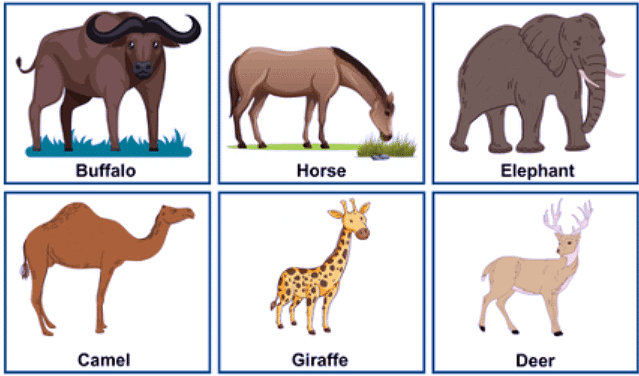
Carnivores
(a) Carnivores are animals that like to eat other animals.(b) They are hunters and their preferred food is meat.
(c) They have special skills to catch and eat their prey.
(d) Tigers, cheetahs, wolves, snakes, and sharks are some examples of carnivores.
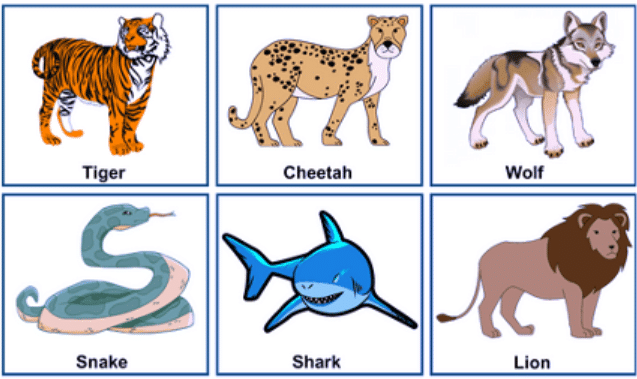
Omnivores
(a) Omnivores are animals that can eat both plants and animals.
(b) They have flexible diets and can eat a variety of foods.
(c) They can enjoy nuts, fruits, vegetables, fish, eggs, and even insects.
(d) Humans, monkeys, bears, and raccoons are a few examples of omnivores.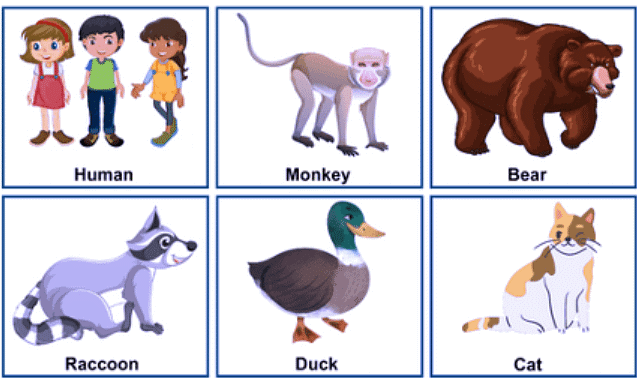
Scavengers
(a) There are some animals that have a special job of cleaning up the remains of dead animals. We call them scavengers.
(b) Scavengers like hyenas, vultures, and jackals help keep the earth clean by eating the leftover parts of dead animals.
|
44 videos|50 docs|82 tests
|
FAQs on Animals Chapter Notes - Science Olympiad for Class 2
| 1. What are the different classifications of animals based on their habitats? |  |
| 2. Can you provide examples of domestic animals? |  |
| 3. What are some examples of wild animals? |  |
| 4. Which animals are classified as water animals? |  |
| 5. What are some examples of land animals? |  |




















